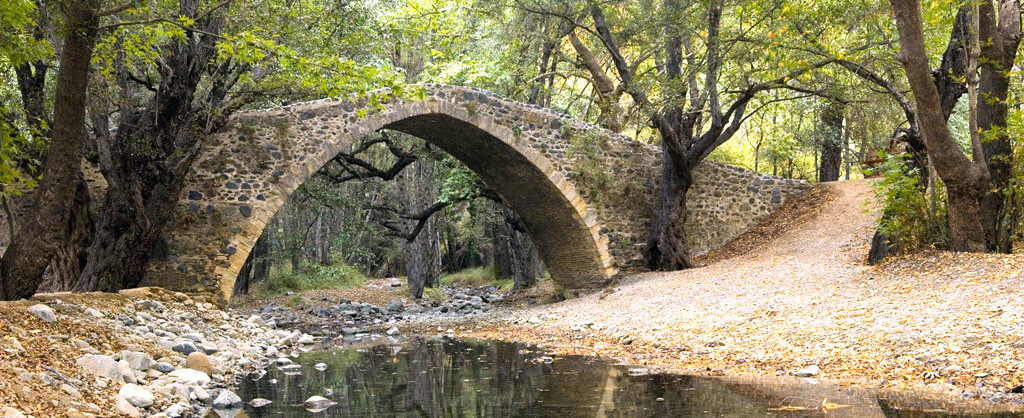Today’s journey takes us to one of the most unusual historical monuments of the Тroоdos mountains– the Venetian bridges.
In 1489 Catherine Cornaro, who was the last queen of the Lusignan dynasty, abdicated in favour of Venice. The Venetians regarded the island as the last bastion for opposition to the Turkish expansion. They erected military fortifications in Cyprus and powerful defensive walls around cities; a wonderful example of the architecture of that time is the preserved Venetian walls in Nicosia.
The wonderful bridges in Troodos were also inherited from the Venetians. It is presumed that they were built in the 16th cеntury when the Venetians laid roads through the mountains to carry cargo (including copper and iron ore). People say that even camel caravans, carrying loads weighing 200 – 500 kg, were taken over them.
Over time the path was abandoned, but its name, Kamilostrata (or the “camel way”), is preserved. This was the name of a route that ran parallel to the path, which we will take today, a part of which is the Venetian bridges. Travelers will see about 130 types of plants whose names are shown on special plates along the route, which is 17 km long and stretches from the abandoned village of Vertsia tо a place called Kaminaria. Let’s start the enthralling journey!
When taking the ancient path we will become acquainted with the exquisite and majestic bridges of Elia, Tzielefos, Rudjas and Skarfos, which are hidden in the depths of a forest between mountain rivers.
The Elia Bridge
The beautiful Elia, which is about 5.5 m high and 15.5 m long, was built in a forest hollow on the river of Phini. You will see a fast stream of water that seems to run away and hide in the depths of the rocks. Travelers come to the bridge and stop, mesmerized by its mysterious beauty. In the middle Ages people had a lot of time to spare and constructed buildings with taste – perhaps this is why the bridges are so delicate and poetic.
The Tzielefos Bridge
Another Venetian guard, Tzielefos, is located 4 km away from Elia. This bridge seems to pose for photographers, demonstrating its handmade beauty and amazing natural framing. It so happened that it became the most famous of all middle age bridges оf the island.
Everyone loves the bridge – locals, pedestrians, jeep-safari tourists and newlyweds. Tzielefos is the longest of all the four bridges. It’s 30 m long, 6 m high and 3.2 m wide. The bridge towers above the river Rudiya.
Only voices of nature break the silence near the bridge – grasshoppers chirrup, frogs splash, life of other forest and water inhabitants is ebullient here. Small crabs and evasive gerridaes-skiers live in the river.
Effusive sycamores and wonderful alder trees are spread loosely on the banks of the river. Tourists usually rest on benches under an alder tree and snack on food they have brought.
The Rudjas Bridge
After Pera Vasa, on a fork, you should turn to the right and, following the Mylikouri sign, drive for about 16 km. A bit further, at another fork, you should follow the Panagia sign, which will lead you right to the bridge, to a thick and tall forest, which bears down on ‘guard’ from all sides.
Everything here seems to be hiding and standing still. Here Rudjas — overgrown with moss like a hunchbacked forest monster 28 meters long and 3.7 meters wide – lies low, but the silence is mysterious here! Rudjas seems to be waiting for travelers to start looking for it and break the silence with conversations and amazed exclamations.
Another route taking you to the bridge lies from the village Galataria towards the abandoned little village of Vertsia. Time seems to have frozen here, and only shadows of the past noiselessly glide along the deserted paths and abandoned houses.
The Skarfos Bridge
Specialists of the antiquity department discovered an embossed stone cross on the front of the outer curve of the arch, under which was the date 1618. The bridge was built from special carved asbestos stones and covered with square asbestos stones. Although very little was left from the initial construction, Skarfos was fully restored.
Painters love to come to Skarfos and, when left alone with it, draw its exquisite semicircular arc. Its sophisticated beauty appears later in pictures.
Conclusion
It seems incredible how many historical monuments of different eras hide on the small island. While travelling from one bridge to another, you seem to plunge into the atmosphere of the middle age construction, art and a special mystery of these forest places. You feel indescribable emotions at that!
